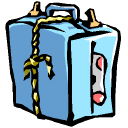How
to Pick the Perfect Luggage
by
Denise McCluggage
 Mobility,
flexibility, expandability, compatibility, packability. Mobility,
flexibility, expandability, compatibility, packability.
All
those “abilities” should be your guide when you choose your travel equipage.
And that goes for both luggage and what you put into it.
Let’s start with exteriors for now - your luggage, part one.
If
you haven’t yet taught your bags to heel, get with the program. It’s
far easier to roll a bag than lug it by its handle or dangle it from your shoulder. The
wheel has been invented and found good. So either buy a bag with built in wheels
or get a luggage cart of some sort. Those
devices of collapsible tubing, large wheels and bungee cords are inexpensive and
do the trick, but they pose almost as many problems as they solve. Airlines do
not permit them to be carried in overhead bins, they are awkward underfoot and
are easily damaged when checked. Try
instead the lightweight, flat-folding ones that fit in a carry on. One such is
the CompacCart by Moveasy. The 100 model weighs three pounds and carries 40 pounds,
the 200 weighs five pounds and totes 110 pounds. (Try EzShop.com.
Similar carts can be found at eBags.com
and one called Roleasy at Magellans.com) When
wheels first appeared on bags they showed up on four corners at the bottom of
conventional suitcases. These were pulled with attached leashes. This arrangement
- still around - is notoriously unstable tipping easily in corners, making for
a high annoyance quotient. Airline
personnel were the first to adopt the now ubiquitous dual-wheel vertical cases
that are towed by a pullout handle, wide side at your heels. Variations quickly
hit the market and now some are even pulled narrow side. These are obviously easier
to tow down narrow airline aisles, but their narrow wheel base makes them inherently
less stable when dodging about busy airports. All
the cases have some way to attach smaller pieces (handbags, briefcases, computer
carriers, etc.) to them. The first ones used a detachable J-shaped wire hook to
hold the add-ons. Theses hooks had a penchant for detaching themselves and getting
lost forever in overhead bins and taxi trunks. More satisfactory are today’s
adjustable, removable, stow able straps. On
some matching sets of luggage the smaller bag has an open sleeve that slips over
the pulling handle of the larger bag. This solves any problems of the smaller
bag sliding off to one side and unbalancing the towing operation as you indulge
in gate-to-gate airport aerobics. Travel
tip: It’s a fact of physics that if the most weight is carried low and away
from the fulcrum (your towing hand on the handle) it makes for easier pulling.
Tip PS: Sometimes with heavier or poorly balanced loads try pushing rather than
pulling. But
before we leave wheels, consider their size and construction. Most rolling bags
now use inline-skate wheels, which roll easily and in relative stealth. The wheels
on one of my first rolling bags had wheels without ball bearings. They overheated
easily and then would bind so that the bag was being dragged rather than rolled.
(They were also as annoyingly noisy as squeaky shoes at a funeral.) A
final word about wheels: If you often traverse rough terrain in parking lots,
mount curbs or steps or tow over thick carpeting, look for the largest wheels
you can find to ease your task. Besides
the mobility of wheels consider the size and empty weight of your bags.  Some
airlines are stricter than others but if you want to have a bag you take with
you aboard most of the world’s airlines limit your search to those that do
not exceed 21” or 22” in length (with all the dimensions totaling 45”
or less.) Southwest, TWA and US Airways are the most generous allowing a 24”
bag with a total of 50” for a carry on. (Check carry-on limitations for most
airlines on www.ebags.com.) Some
airlines are stricter than others but if you want to have a bag you take with
you aboard most of the world’s airlines limit your search to those that do
not exceed 21” or 22” in length (with all the dimensions totaling 45”
or less.) Southwest, TWA and US Airways are the most generous allowing a 24”
bag with a total of 50” for a carry on. (Check carry-on limitations for most
airlines on www.ebags.com.)
The
empty weight of a bag, particularly a carry on, is important because a bag heavy
to begin with might require an extra Wheatie to heft into the overhead once it’s
packed. Of course, somebody might come to your assistance (prompted by their own
self-preservation if they are seated nearby), but my travel maxim is: “Never
take more than you can handle alone.”
More Luggage Tips
|